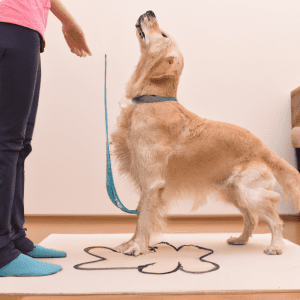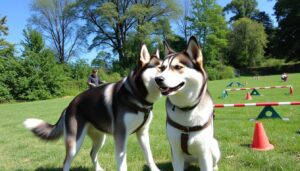How to train a dog to attack?
Training a dog to attack can be a difficult and potentially dangerous task. It requires patience, consistency, and a great deal of time and energy to get it done properly. While it may seem like a daunting task, it is possible to train a dog to attack in a controlled and safe manner.
This guide will give you an overview of the steps necessary to properly train a dog to attack, as well as provide some tips to make the process easier. With the right approach and lots of patience, you can teach your dog to attack command in a way that is both safe and effective.
Teaching Your Dog the Basics of Attack Training
Attack training for your dog may sound intimidating, but it’s actually quite simple. With the right instruction and a lot of patience, you can teach your pup the basics of attack training. Here are some tips to get you started.
- Start by teaching your dog basic obedience commands such as sit, stay, come, and heel. Make sure your pup understands these commands before moving on to attack training.
- Choose an appropriate target for your dog’s attack training. A stuffed animal or a pillow are good options. 3. Have your pup focus on the target by giving a command such as “attack.” Reward your pup with treats or praise when they focus on the target.
- Once your pup has mastered the basic command, introduce a verbal cue such as “bite” or “hold” to indicate when your pup should start and stop the attack.
- Gradually increase the intensity of the attack by introducing a tug toy or a sleeve for your pup to bite on. Make sure to encourage your pup and give them lots of praise throughout the training.
- End the training session with a reward and lots of praise. This will help your pup understand that attack training is something positive and rewarding. With patience, consistency, and lots of positive reinforcement, you can teach your pup the basics of attack training. Just remember to take it slow and keep the training fun for both you and your pup.
Choosing the Right Method of Attack Training for Your Dog
If you’re looking to give your canine some extra training, then attack training is a great way to do it. It’s an important skill for any dog to have and can help you protect your pup from potential threats.
But there are a few different methods for attack training a dog, so how do you know which one to choose? First, you want to make sure you’re selecting a method that matches your pup’s personality.
Some dogs may be more comfortable with an aggressive approach, while others may be more suited to a more passive one. It’s important to read up on the different methods and understand which one is the best fit for your pup.
Second, take into consideration the environment in which your pup will be receiving the training. If you’re in a home setting, it’s important to choose a method that is safe and won’t cause any harm to your pup.
If you’re in a more public setting, then there are certain methods that are more appropriate than others, depending on the space and safety regulations. Finally, make sure you have a good understanding of the basics of attack training.
This includes knowing the proper commands and cues, as well as understanding the different types of reward systems. With the right knowledge and preparation, you can get your pup ready for whatever situation may arise.
By taking the time to research the different methods of attack training and selecting the one that is best suited for your pup, you can ensure that they get the best possible training. With your pup’s safety in mind, make sure you choose the method that is right for them.
Understanding When and How to Reward Your Dog During Attack Training
When training your dog for attack scenarios, rewards are an essential part of the process. Rewarding your dog for good behavior and for completing commands is a great way to reinforce the behavior you want them to exhibit.
It’s important to understand when and how to reward your dog during attack training so that you can make the most out of your training sessions. When to Reward Your Dog The best time to reward your dog during attack training is when they have successfully completed a command.
This could include when they have executed a command properly, responded to a cue, or followed through with an action. It’s also important to reward your dog at the end of a session, as this is a great way to let them know that you are happy with their performance.
How to Reward Your Dog When it comes to rewarding your dog, there are a few different options. The most common type of reward is a treat, such as a piece of food or a chew toy. However, verbal praise and petting are also great ways to reward your dog for its good behavior.
It’s important to keep in mind that rewards should be given quickly after your dog completes the command in order to reinforce the behavior. It’s essential to understand when and how to reward your dog during attack training in order to get the most out of the process. By understanding when to reward and how to reward, you can successfully train your dog for attack scenarios.
Introducing Your Dog to Attack Training Equipment
Are you interested in getting your dog into attack training? If so, you’ll need some specialized equipment to ensure your pup is safe and can perform its best. This guide will help you get familiar with the different types of attack training equipment available and how to properly introduce them to your pup.
First, it’s important to understand that attack training should only be done by someone with experience and the right safety gear. Make sure you’re properly educated before you begin. Once you’re ready, you’ll need to find the right equipment for your pup.
You’ll want to find something that fits your pup’s size and gives you maximum control. The most common equipment used in attack training includes bite suits, bite sleeves, bite sticks, and weighted bags.
Bite suits are made of thick material and are used to protect the handler during training sessions. Bite sleeves are smaller and used to teach your pup how to properly grip and release an object.
Bite sticks are used to simulate an attack and help teach your pup how to respond to one. Weighted bags are used to increase your pup’s strength and agility. When introducing your pup to attack training equipment, it’s important to go slowly and build up their confidence.
Start by showing them the equipment and letting them explore. Don’t force them to interact with it if they don’t want to. Once they’re comfortable, you can start introducing them to the different pieces of equipment and slowly increasing the difficulty. By taking your time and introducing your pup to attack training equipment slowly and safely, you’ll help ensure they’re comfortable and ready to perform their best.
Incorporating Obedience Training into Attack Training
Attack training is a great way to give your dog discipline and build trust between you and your pup. It can also be used for protection or just for fun. But obedience training is also an important part of the process.
When you incorporate obedience training into attack training, you’ll be able to get the most out of the experience. Not only will you have a better bond with your pup, but you’ll also be able to trust that your dog will respond to commands in a stressful situation.
So how do you incorporate obedience training into attack training? First, you need to make sure that you’ve taught your pup basic obedience commands such as sit, stay, come, and leave it. You should also practice these commands regularly to make sure your pup is comfortable with them.
Once your pup is comfortable with the basics, you can start to teach him more complex commands. This includes commands like “attack,” “release,” and “defend.” These commands are important because they allow you to control your pup’s behavior in a stressful situation.
When you’re ready to begin attack training, make sure that you start slowly. Don’t rush your pup into anything too intense too soon. Start by introducing a stuffed toy or a dummy to your pup and make sure he’s comfortable with it.
Then, begin to practice the commands you’ve taught. Praise your pup when he follows the commands and give him treats for a job well done. By taking the time to incorporate obedience training into your attack training, you’ll be able to get the most out of the experience. Not only will your pup be better behaved, but you’ll also have trust that your pup will respond to commands in a stressful situation.
Overcoming Common Issues When Training a Dog to Attack
Training a dog to attack can be a difficult process. It requires patience, consistency, and dedication from both the trainer and the dog. Below are some common issues that can arise during the training process and how to overcome them.
- Fear of the Target: If your dog shows fear when approaching the target, it is important to move slowly, using positive reinforcement and rewards. Start by getting your dog used to the target from a distance. Gradually move closer to the target, rewarding your dog for remaining calm.
- Lack of Focus: It is important to keep your dog’s attention during the training session. If your dog is easily distracted, try using a treat or toy to keep their focus. You can also break up long training sessions into smaller, more manageable chunks.
- Too Much Excitement: If your dog is too excited when approaching the target, it can be difficult to maintain control. In these cases, it is important to reduce the level of excitement by using a calm, low-energy voice and touch. You can also use treats to reward calm behavior.
- Low Drive: If your dog is lacking motivation, it is important to make the training more exciting. Try using different targets and rewards, or incorporating more challenging tasks. By addressing these common issues, you can ensure that your dog is properly trained to attack. With patience and consistency, you can teach your dog the skills necessary to protect yourself and your family.
Tips for Training a Dog to Attack on Command
- Start with basic obedience training. Before you can start teaching your dog to attack command, they need to be able to understand basic commands like sit and stay. This will lay the groundwork for the more advanced commands you’re about to teach.
- Teach them to associate a command with a specific action. To teach your dog to attack command, you need to start by teaching them to associate a simple command like “attack” with the action of attacking.
- Use treats as rewards. Positive reinforcement is the best way to train a dog. When your dog successfully performs the desired action, give them a treat as a reward.
- Give the command in a firm, clear manner. Your dog needs to be able to clearly understand the command, so make sure you give it in a firm, clear tone.
- Start with slow movements. You don’t want to start off with too much intensity or your dog may become overwhelmed. Start by having them lunge at an object or person slowly, and then gradually increase the speed.
- Don’t forget to praise. After each successful attack, make sure to give your dog lots of praise and love. This will help reinforce the behavior and make it more likely for them to obey the command in the future.
- Practice, practice, practice. Like any skill, your dog needs to practice to become proficient in attacking commands. Make sure to practice regularly so your dog can become familiar with the command and the action.
Safety Considerations for Dog Attack Training
- Make sure you have the right equipment. You’ll need a bite suit, a bite sleeve, and a head guard. Bite suits are designed to protect the trainer from the canine’s bite, while bite sleeves and head guards provide extra protection and help the trainer to redirect the dog’s energy.
- Ensure that the dog is properly trained and socialized. Before starting any attack training, it is important to make sure that the dog has been well-socialized and has a basic understanding of commands.
- Start slowly. Don’t rush into attack training. Start with basic commands and gradually increase the intensity of the training as the dog becomes more comfortable.
- Don’t use punishment when training. Punishment can cause the dog to become fearful or aggressive, which can be dangerous. Instead, use positive reinforcement to reward the dog when it follows commands.
- Be aware of the dog’s body language. Watch out for signs of aggression or fear, such as growling, baring teeth, or avoiding eye contact. If the dog is displaying any of these signs, take a break and reassess the situation.
- Always keep safety first. Make sure that any training is done in a controlled environment with an experienced handler. Never leave a dog unattended, and never allow an untrained person to handle the dog.
- Know when to stop. Attack training can be physically and mentally exhausting for both the trainer and the dog. If the dog is showing signs of fatigue or discomfort, end the training session.
Training a dog to attack requires patience and consistent reinforcement of desired behaviors. The most important thing to remember is to be consistent in your commands and rewards.
Be sure to start with basic obedience commands, like sit and stay, and gradually introduce more complex commands. Introduce rewards for desired behaviors and punishments for undesired behaviors. Use treats, toys, and verbal praise to reward desired behaviors and corrections or time-outs for undesired behaviors. With patience and consistency, you can train your dog to attack when needed.




